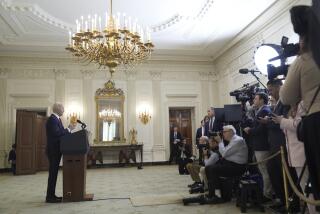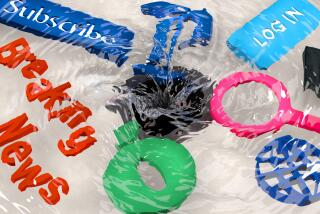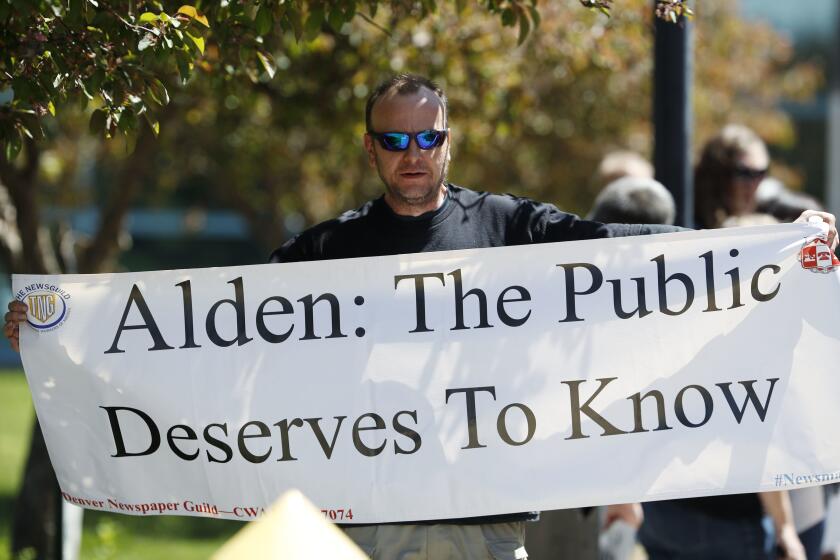On the Media: Arianna Huffington’s new challenge
Nearly six years after she launched a “group blog” to let her big-name friends air their views, Arianna Huffington returned to Los Angeles Tuesday on a triumphal tour, after selling her website to AOL for $315 million.
Hardly anyone viewed Huffington Post in 2005 as something that could become a major media player. It seemed to be more like an online salon, where Arianna’s many rich and famous friends — from Walter Cronkite to Norman Mailer, Nora Ephron and former U.S. Sen. Gary Hart — would come to bat around politics.
That Huffington Post arrived as one of the biggest news destinations on the Internet is not a triumph of Walter and Norman and Nora, though. It’s a testament, instead, to the drawing power of Kim and Christina and Jennifer. While the top headlines at Huffington Post blared about the AOL deal and revolution in Egypt this week, some of the most furious clicking was on headlines like these: “Kim Kardashian Loves ‘W Magazine’ Nude Photos,” “Christina Aguilera Totally Messes Up National Anthem” and “Jennifer Aniston Wears Bra Vibrator On ‘The Ellen DeGeneres Show.’”
What started like an exclusive club morphed into a watering hole for everyone. Most of Huffington Post’s millions of readers today know not a whit about Arianna and her well-heeled friends. But they have a sense that the woman with the honeyed Greek accent provides them one of the quickest portals to gossip, sports, fashion, books, religion and more.
Huffington Post now ranks as one of the 10 most popular news and information destinations in America. Its 24.5 million unique monthly visitors come mostly not to read its original reporting. (My memory might fail, but I don’t recall a really big scoop on the site since a citizen blogger caught candidate Barack Obama dissing “bitter” blue-collar voters.)
The audience, instead, finds Huffington Post content mostly drawn from other sites, brilliantly chosen to reflect the whims of the moment and ingeniously posted (mastering the dark science known as search engine optimization, SEO) so that Google searchers arrive there first.
Pioneering blogger and Web designer Jason Kottke tweeted, somewhat derisively it seemed, that the $315-million AOL deal announced Monday seemed to make Huffington Post’s sale “the biggest exit ever for an SEO company.”
But can Huffington ride that knack for “curation” and “aggregation” and her supernatural talent for networking and promotion to success as editor of all AOL content, which ranges from her own site and its nearly two dozen “sections” to a long menu of AOL sites, from TechCrunch and Engadget to MapQuest and Moviefone?
What we know now is that most advertising-based websites struggle economically. The vast inventory of sites and pages and the persistently low rates for online advertising have left sites in endless pursuit of bigger audiences — hoping to add enough penny clicks together to equal serious ad dollars.
Comscore.com measured AOL News with the seventh largest news and information audience in the U.S. in December, with just over 35 million unique visitors. Together with 10th place Huffington Post (which ranks one spot below an aggregate of all Tribune Co. sites, including its biggest, latimes.com) and all subsidiary AOL sites, the merged company claims an audience of 117 million.
Will that provide enough reach to make the paltry Internet ad rates finally pay off? The range of opinions has run the gamut from skeptics like Newsweek’s Dan Lyons (“It’s a slow-motion train wreck and will end in disaster”) to optimists like new media strategist Jeff Jarvis, who predicted the naysayers were underestimating Huffington, again.
“What HuffPo and Arianna bring is a new cultural understanding of media,” Jarvis wrote on his Buzz Machine blog, “that is built around the value of curation, the power of peers, the link economy, passion as an asset, and celebrity as a currency.”
As of Sunday afternoon, Huffington and AOL boss Tim Armstrong were sitting in a luxury box at the Super Bowl, waiting for the final contracts on their deal to be signed. When they got word, at halftime, they flew to New York, where Huffington began a whirlwind of Monday television interviews. An AOL corporate jet whisked them late that night back to her home base of Los Angeles, where she and Armstrong appeared Tuesday morning before a gathering of marketers and public relations executives.
Armstrong clearly had been reading the early reviews about the deal. He knew that several accounts had compared AOL’s purchase to Yahoo’s purchase of Associated Content and to the initial public offering of stock for Santa Monica-based Demand Media. Those “content farms” shovel low-quality, low-cost stories, pictures and videos onto the Internet. They then use this “inventory” as a platform for ads and, voila, profits.
Armstrong clearly didn’t appreciate the comparison. “Let me underline something else,” he told the conference at a hotel near the Beverly Center. “People are writing a lot about content factories and those things. This [merger] is about brands.... We are working on brands that are going to stand the test of time in the next version of the Internet.”
That may be. Despite its largely volunteer labor force, Huffington Post now has hired on a total of 210 full-time reporters, editors, techies and others on its payroll. It covers Washington and foreign affairs earnestly. That alone makes it a more substantial news outfit than the purely click-driven mercenaries.
But the AOL boss also sits atop an organization that produced a memo, “The AOL Way,” that gives, at best, a hint of any nobler aspirations. The document, recently leaked to the media, describes how editors for the company are supposed to pick topics based largely on how quickly they can be posted, how many readers they will draw and how much ad revenue that might produce.
Editorial quality also got a mention in the memo. But the bottom-line tone suggests a bid for traffic by any means. That would seem to position Huffington, herself notoriously hard-charging, as the kinder, gentler half of the new AOL partnership.
She talked on Tuesday about extending her Christmas tradition of buying sweaters for her staff to AOL. Armstrong said he had built it into the budget. She also insisted on “humanizing everything,” including adding a “nap room” at her new company.
Armstrong responded: “Yes, where you can nap from 10 p.m. until 6 in the morning.”
Twitter: latimesrainey
More to Read
The biggest entertainment stories
Get our big stories about Hollywood, film, television, music, arts, culture and more right in your inbox as soon as they publish.
You may occasionally receive promotional content from the Los Angeles Times.











